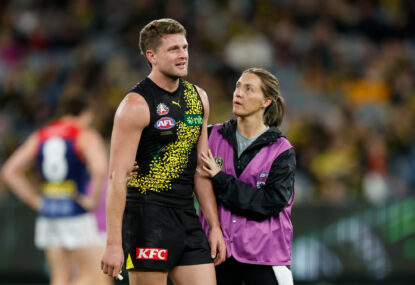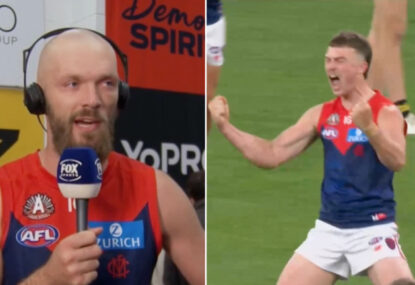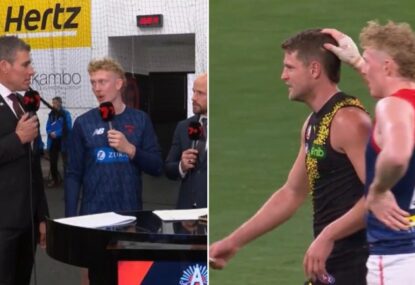We move to the J team, and one of the most dynamic forward lines of any squad thus far.
Back line
Horrie Jenkin (Fitzroy 1916-28)
169 games, 22 goals
Horrie Jenkin played at both ends of the ground during his time at Geelong, settling into a full back role and developing a reputation as one of the best. At full forward in his first year, he won a premiership before a second flag in 1922 as full back. In 1926, Jenkin won Fitzroy’s best and fairest, and retired in 1928. Gordon Coventry described him as one of the most vigorous defenders of the era.
Tassie Johnson (Melbourne 1959-69)
202 games, 20 goals
After two seasons with North Launceston, Bob ‘Tassie’ Johnson stood out of football for the 1958 season to win a transfer to Melbourne. He made an immediate impact as a defender, playing in the Demons’ 1959 and 1960 flags as a full back and shifting to the back pocket for the 1964 flag. Nicknamed ‘Tassie’ as there was already another Bob Johnson on the Melbourne list, he was a regular in Victorian sides through the 1960s, and became the first Tasmanian to reach 200 VFL games. His standing was such that he was named captain for 1969, although the club won its first wooden spoon since 1951 that same year. Johnson was named as full back in both the Tasmanian Team of the Century, and Melbourne’s Team of the Century.
Chris Johnson (Fitzroy 1994-96, Brisbane 1997-2007)
264 games, 172 goals
A hard-running, close-checking defender in his time at Brisbane, Chris Johnson started his career with Fitzroy as a skilled utility who led the club’s goal-kicking in 1995. As one of the eight players selected to move to Brisbane as part of the merge, he developed into one of the finest attacking defenders of the era. Johnson played in each of the Brisbane premierships of 2001-03, and was named All Australian in 2002 and 2004. In his final year of 2007, he was named as one of five club captains, retiring as the last former Fitzroy player still in the league. Johnson was named as back pocket in Brisbane’s Team of the Decade 1997-2006, and in the Indigenous Team of the Century.

(Photo by Michael Dodge/AFL Media/Getty Images)
Half back line
Austinn Jones (St Kilda 1995-2005)
226 games, 127 goals
For 11 years, the sight of Austinn Jones streaming from half back was a familiar one for Saints fans, best exemplified in the 1997 grand final when he went the length of the field to kick an inspiring goal in the first quarter. Twice winning All Australian selection, Jones spent a few years as an inconsistent wingman before shifting to the half back flank and developing into one of the finest exponents of the position in the early 2000s. His retirement at only 29 came as a shock as he was expected to feature in the Saints’ push for a second premiership in the second half of the decade.
Glen Jakovich (West Coast 1991-2004)
276 games, 60 goals
Glen Jakovich retired as the games record holder for the West Coast Eagles after 14 years as one of the preeminent defenders in the league. He played in the 1992 and 1994 premierships, and won best and fairest awards in 1993, ’94, ’95 and 2000. During the 1990s, the duels between Jakovich and Wayne Carey were a top attraction. An injury in 1996 dulled his effectiveness, but he was able to modify his playing style to still be an imposing figure.
John James (Carlton 1953-63)
195 games, 31 goals
In his first season, John James was stationed on the half forward flank and kicked eight goals, 43 behinds. Understandably, he was shifted to defence, where he became a standout for the Blues throughout a dry period. Winning best and fairest awards in 1955, 1960 and 1961, James won the Brownlow Medal in 1961 while using his trademark dash. Occasionally his disposal was poor, but his competitiveness and ball-winning skill made up for it. Such was James’ quality that he was often thrown around the ground by coaches in order to inspire the team. He represented Victoria in 15 matches, and was named on the half back flank in Carlton’s Team of the Century.
Centre line
Noel Jarvis (Fitzroy 1944-52)
159 games, 31 goals
Noel Jarvis had an auspicious start to his career with Fitzroy, playing in both a reserves and seniors premiership in his debut season of 1944, having broken into the senior team halfway through the year. Best known for his pace and reflexes enabling him to pick up a fumbled ball almost instantly, Jarvis represented Victoria in 1947 and 1952. In 1948, he was listed in Sporting Life’s Team of the Year. A consistent presence for the Lions during his career, Jarvis played between 17 and 20 matches in every season of his career except his debut year.
Nathan Jones (Melbourne 2006-)
287 games, 138 goals
A stalwart for Melbourne throughout his career, Nathan Jones is a tough midfielder who can fight for the inside ball but still be able to distribute well when in space. A sign of things to come came in 2007 when he was runner up in the club’s best and fairest award, eventually winning it in three straight years from 2012-14. In 2014 Jones was named as Melbourne’s captain and held the role until the end of 2019. He may end his career as only the second Demon to play 300 games for the club.
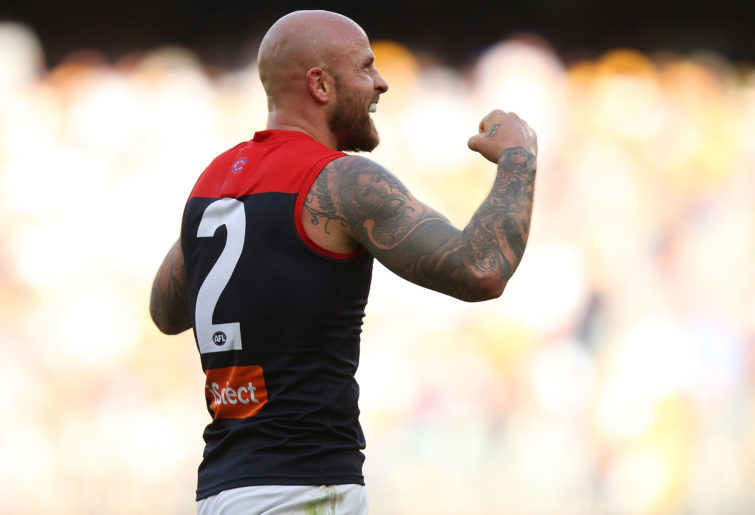
(Photo by Paul Kane/Getty Images)
Syd Jackson (Carlton 1969-76)
136 games, 165 goals
After starring in the WAFL, Syd Jackson attracted plenty of attention from VFL scouts before signing with Carlton. At the Blues, Jackson would play primarily as a creative forward flanker, with courage and marking ability to spare. During his career, he was the only Aboriginal player in the VFL so was often subjected to racist taunts by opponents, eventually lashing out at Lee Adamson in the 1970 semi-final. Jackson claimed extreme provocation and was found not guilty, allowing him to star in the club’s famous grand final comeback. Twenty-two years later, Jackson apologised to Adamson, stating that the racist allegations were fabricated to prevent him from being suspended. Another flag for Jackson followed in 1972, and he continued to play good football up until his retirement in 1976. He was named on the half forward flank of the Indigenous Team of the Century.
Ruck line
Hugh James (Richmond 1909-23)
188 games, 119 goals
Only after two failed try-outs at other clubs did Hugh James find a role at Richmond as a scrupulously fair ruckman who would rest in the back line with a superb one-grab marking ability. He represented Victoria on six occasions and was part of Richmond’s first two premierships in 1920 and 1921. Between 1916 and 1919, Lt. Hugh James served in the AIF and was awarded the Military Cross in 1918 for his bravery on the battlefield. He won best and fairest awards in 1921 and 1923 before retiring to concentrate on business.
Chris Judd (West Coast 2002-07, Carlton 2008-15)
279 games, 228 goals
It’s not often that one player dominates the annual trading period to the extent that Chris Judd did when he announced his return to Victoria in 2007. At West Coast he had already won a Brownlow Medal in 2004, a Norm Smith Medal in 2005, a premiership in 2006, and two best and fairest awards as one of the most explosive and skilful midfielders in the competition. Carlton eventually won the race for Judd’s services, and he went on to win three more best and fairest awards and another Brownlow Medal in 2010 in a more inside role. Judd captained Carlton from 2008-12 before stepping down for the last three years of his career. He retired in 2015 after rupturing his ACL.
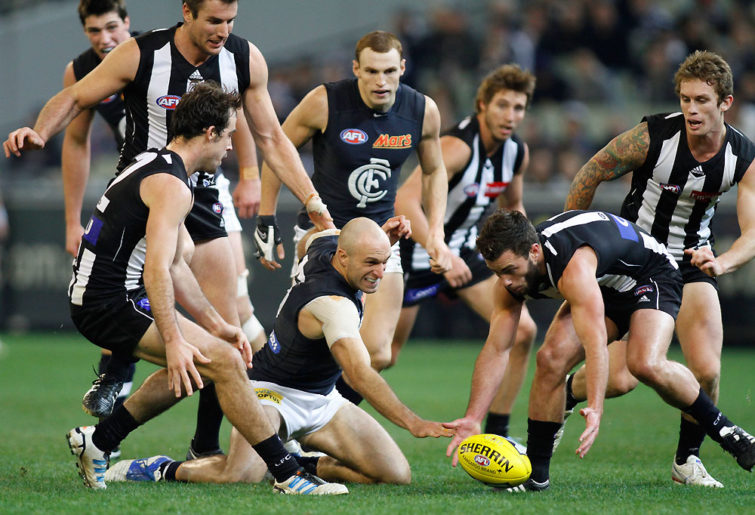
(Photo: Greg Ford/AFL Media)
Wayne Johnston (Carlton 1979-90)
209 games, 283 goals
Wayne Johnston lived for the big games. Nicknamed ‘The Dominator’, he was arguably one of the best on ground in three of the four premierships he played in (1979, 1981, 1982, 1987) and a consistent presence in the players listed ‘Best’ in any finals match. As an aggressive and hard-running midfielder, Johnston was able to pop forward for crucial goals throughout his career, even leading Carlton’s goal-kicking in 1980. He captained Carlton in 1984 and 1985, and won best and fairest awards in 1983 and 1986 before injury started to slow him in the final years of his career. Johnston was named on the half forward flank of Carlton’s Team of the Century, and is one of ten official club legends.
Half forward line
Jack Jones (Essendon 1946-54)
175 games, 156 goals
Jack Jones wore the number 24 during his career at Essendon to honour the 24th Infrantry Battalion that he served with during World War II. Upon his return from the war he turned into a consistent presence in the Bombers’ teams of the day, playing in the 194, 1949 and 1950 premierships. Jones was able to use his pace well or move into the ruck when necessary, and his durability was such that he holds the Essendon record for most consecutive games, with 133. He left Essendon to captain-coach Albury in the Ovens and Murray League.
Bob Johnson Jr (Melbourne 1954-61)
140 games, 267 goals
The son of 1926 premiership player Bob Johnson Sr, the younger Bob Johnson edges him out of this team by dint of greater team success during his career and extra versatility. Johnson was one of the tallest players in the VFL during his career, and would often rest forward as a goal-kicking option for the Demons. In each of his first seven seasons Melbourne reached the grand final, meaning that Johnson played in five premierships (1955-56-57, 1959-60). He led Melbourne’s goal-kicking in 1956 and 1961, and after transferring to East Fremantle he was an effective goal-kicker there too. Johnson was named as an emergency in Melbourne’s Team of the Century.
Steve Johnson (Geelong 2002-15, GWS 2016-17)
293 games, 516 goals
If not for a wake-up call after the 2006 season when he was arrested and subsequently suspended by the club for the first five matches of 2007, Steve Johnson could have ended up as an unfulfilled talent. Instead, he went on to kick nearly 50 goals as the Cats marched to the premiership, and Johnson won a Norm Smith Medal. Capable of kicking goals from anywhere, Johnson was named All Australian on three occasions and led Geelong’s goal-kicking in 2008 and 2010. Towards the end of his career at Geelong he moved more into the midfield, before moving to GWS and sharing his experience for two years.
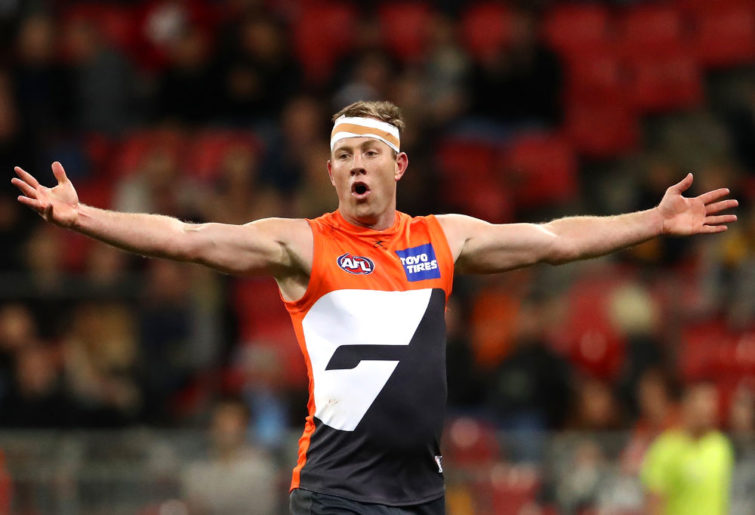
(Photo by Cameron Spencer/Getty Images)
Forward line
Brad Johnson (Footscray/Western Bulldogs 1994-2010)
364 games, 558 goals
Brad Johnson was known throughout his career for having a constant smile on his face while playing. Playing as a midfielder who could move forward when necessary, Johnson was tough and determined to win the ball whatever the cost. Later in his career he moved forward more often, finishing second in the Coleman Medal in 2006 and leading the club’s goal-kicking on five occasions. He was also named All Australian six times, and named as captain in 2006. Johnson won three club best and fairest awards, captained the club from 2007-10, and retired as the Bulldogs’ record holder for games played.
Alex Jesaulenko (Carlton 1967-79, St Kilda 1980-81)
279 games, 444 goals
“Jesaulenko, you beauty!” The call continues to be famous in football folklore 50 years after the fact, and the man responsible for the mark, Alex Jesaulenko, is a revered name in football circles. Jesaulenko could play in any position on the field with equal effectiveness, starring in the midfield in his first season (finishing third in the Brownlow Medal), becoming the only Carlton player to kick 100 goals in a season as full forward in 1970, and winning a best and fairest as centre half back in 1975. With a freakish marking ability and uncanny knack for winning the ball, Jezza’s spectacular marking was a feature of the 1960s and 1970s. He ended his time as Carlton as the last captain-coach of a premiership side in 1979, to go with his 1968, 1970 and 1972 flags. He had a brief coda to his career at St Kilda following internal ructions at Carlton. Jesauelnko was named on the half forward flank of both Carlton’s and the AFL’s Team of the Century, and is a legend in the Hall of Fame.
Darren Jarman (Hawthorn 1991-95, Adelaide 1996-2001)
230 games, 386 goals
Although Darren Jarman was drafted by Melbourne in 1986, he chose to remain with North Adelaide until the formation of the Adelaide Crows saw him reassess his career and move to Hawthorn. He was a highly effective midfielder for the Hawks, winning a premiership in his first year and being named All Australian twice. In 1995 he won the club best and fairest, and finished second in the Brownlow Medal. After being traded back to Adelaide, Jarman became the decisive factor in the Crows’ two premierships of 1997 and 1998, kicking five goals in the final quarter of 1997 and another five goals in 1998 to secure the flags. He led Adelaide’s goal-kicking on three occasions, including his final season of 2001, never kicking less than 36 goals in a season. Jarman was named in the forward pocket of Adelaide’s Team of the Decade.
Interchange
Norm Johnstone (Fitzroy 1944-57)
228 games, 185 goals
A rugged and pacy ruckman who was never afraid to throw his weight around, Norm Johnstone was equally effective in the forward line, where he led Fitzroy’s goal-kicking in 1955. Johnstone represented Victoria in 1948 and won the club best and fairest in 1947. Jack Dyer noted that he was one of the toughest players of the era, never afraid to make his presence known or knock over a pack. In 2001, Johnstone was named in Fitzroy’s Team of the Century.
Jim Jess (Richmond 1976-88)
223 games, 175 goals
Jim Jess was a popular and versatile member of the Richmond squad throughout his career, spending most of his time at centre half back but being able to shift to any key position with equal effectiveness. He was famous for using the torpedo punt as a matter of course, in 1980 kicking in past the centre circle after a behind! Jess was capable of the spectacular as well as the physical, known for giving out a heavy bump when the occasion called for it. He represented Victoria in 1984 and was named All Australian in 1980, a year in which he also celebrated a premiership for the Tigers.
Kieren Jack (Sydney 2007-19)
256 games, 166 goals
The son of rugby league great Garry Jack, Kieren Jack was a small yet determined midfielder for Sydney who started out as a tagger before blossoming into a damaging ball winner in his own right. Nominated for the Rising Star award in 2008 for an effective tag on Daniel Kerr, Jack developed his game such that he won the club best and fairest in 2010. In 2012 he was an important part of Sydney’s flag side, and went on to captain the Swans from 2013-16. From 2017 injury started to take its toll, but he was still a first-choice player up until his retirement.
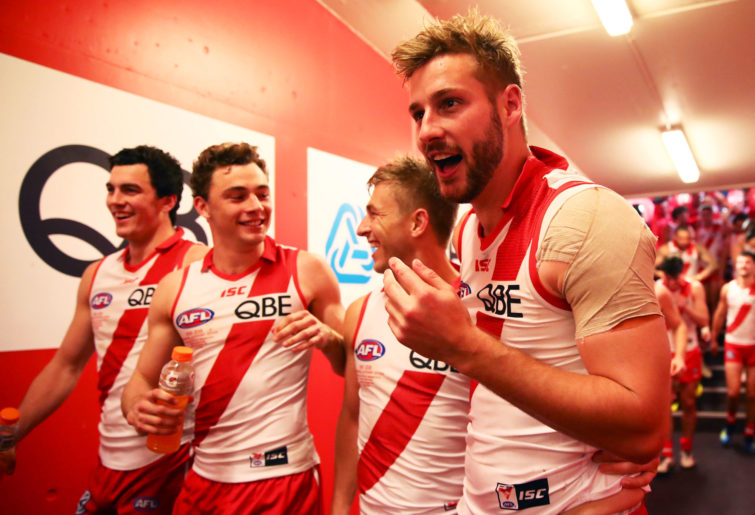
(Photo by Matt King/AFL Media/Getty Images)
Jason Johnson (Essendon 1997-2008)
184 games, 109 goals
Jason Johnson’s first three years at Essendon were inconsistent, with less than ten matches each season. Come 2000, and he stepped up as one of the most prominent midfielders in a team that lost only one match all season. Johnson was part of the premiership that year, and for each of the following five seasons finished in the top three of Essendon’s best and fairest award, winning in 2001 and 2005. He was named All Australian in 2001, and represented Australia in the International Rules series in 2001 and 2004. Johnson retired in 2008 after a foot injury.
Emergencies
Stan Judkins (Richmond 1928-36)
133 games, five goals
It is one of the great ironies that Stan Judkins was initially declared the sole winner of the Brownlow Medal in 1930 using the tiebreaker that he had played less games than Allan Hopkins or Harry Collier – the reason he had played less games was because his form had dropped so much that he was demoted to the reserves! A small yet skilled and courageous wingman, Judkins was part of a famous centre line at Richmond, combining with Eric Zschech and Alan Geddes in four straight grand final years, winning flags in 1932 and 1934. He continued to attract the umpires’ eyes, too, finishing fifth in the Brownlow Medal in 1931 and 1932. Judkins left the Tigers in 1936 and after serving in World War II, helped establish the under-19s competition for the VFL.
Michael Johnson (Fremantle 2005-18)
244 games, 68 goals
Michael Johnson was a versatile and effective player for Fremantle throughout his career, however he spent most of his time in a key defensive position. In his second year he finished in third place in the club best and fairest award, outlining his potential. In 2010 Johnson was named in Fremantle’s leadership group, and was selected as All Australian in 2013 – also being named among the best in the Dockers’ grand final loss. Johnson’s partnership with Luke McPharlin in the key defensive posts was a vital part of Fremantle’s success during this time. Late in his career, he moved up the field to assist Aaron Sandilands in the ruck before retiring in 2018. Johnson was named in Fremantle’s 25 since ’95 team on the half back flank.
Ted Johnson (South Melbourne 1923-31)
136 games, 385 goals
In each of Ted Johnson’s first six years with South Melbourne, he led the club’s goal-kicking, three times kicking 60 goals. Showing remarkable consistency, he kicked over 44 goals in each season up to 1928 before losing effectiveness. As a key forward he had good marking ability, however was occasionally wayward when kicking for goal. He represented Victoria on seven occasions, before leaving South Melbourne to play with Sandringham in the VFA.
Up next is the K team, with three generations of one family all finding a spot in the squad.




































































































